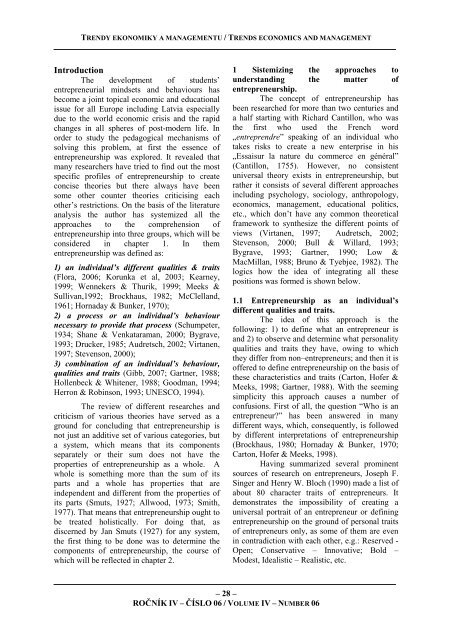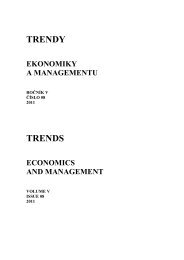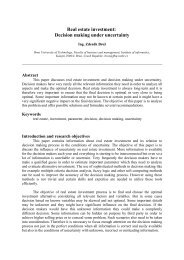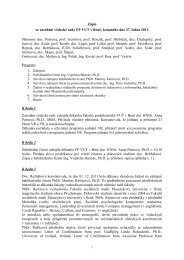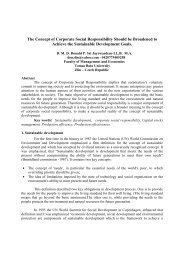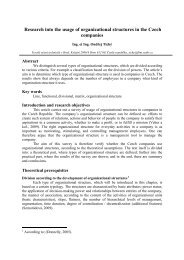Stáhnout toto číslo ve formátu PDF - Fakulta podnikatelská - Vysoké ...
Stáhnout toto číslo ve formátu PDF - Fakulta podnikatelská - Vysoké ...
Stáhnout toto číslo ve formátu PDF - Fakulta podnikatelská - Vysoké ...
You also want an ePaper? Increase the reach of your titles
YUMPU automatically turns print PDFs into web optimized ePapers that Google loves.
TRENDY EKONOMIKY A MANAGEMENTU / TRENDS ECONOMICS AND MANAGEMENT<br />
Introduction<br />
The de<strong>ve</strong>lopment of students’<br />
entrepreneurial mindsets and behaviours has<br />
become a joint topical economic and educational<br />
issue for all Europe including Latvia especially<br />
due to the world economic crisis and the rapid<br />
changes in all spheres of post-modern life. In<br />
order to study the pedagogical mechanisms of<br />
solving this problem, at first the essence of<br />
entrepreneurship was explored. It re<strong>ve</strong>aled that<br />
many researchers ha<strong>ve</strong> tried to find out the most<br />
specific profiles of entrepreneurship to create<br />
concise theories but there always ha<strong>ve</strong> been<br />
some other counter theories criticising each<br />
other’s restrictions. On the basis of the literature<br />
analysis the author has systemized all the<br />
approaches to the comprehension of<br />
entrepreneurship into three groups, which will be<br />
considered in chapter 1. In them<br />
entrepreneurship was defined as:<br />
1) an individual’s different qualities & traits<br />
(Flora, 2006; Korunka et al, 2003; Kearney,<br />
1999; Wennekers & Thurik, 1999; Meeks &<br />
Sullivan,1992; Brockhaus, 1982; McClelland,<br />
1961; Hornaday & Bunker, 1970);<br />
2) a process or an individual’s behaviour<br />
necessary to provide that process (Schumpeter,<br />
1934; Shane & Venkataraman, 2000; Bygra<strong>ve</strong>,<br />
1993; Drucker, 1985; Audretsch, 2002; Virtanen,<br />
1997; Ste<strong>ve</strong>nson, 2000);<br />
3) combination of an individual’s behaviour,<br />
qualities and traits (Gibb, 2007; Gartner, 1988;<br />
Hollenbeck & Whitener, 1988; Goodman, 1994;<br />
Herron & Robinson, 1993; UNESCO, 1994).<br />
The review of different researches and<br />
criticism of various theories ha<strong>ve</strong> ser<strong>ve</strong>d as a<br />
ground for concluding that entrepreneurship is<br />
not just an additi<strong>ve</strong> set of various categories, but<br />
a system, which means that its components<br />
separately or their sum does not ha<strong>ve</strong> the<br />
properties of entrepreneurship as a whole. A<br />
whole is something more than the sum of its<br />
parts and a whole has properties that are<br />
independent and different from the properties of<br />
its parts (Smuts, 1927; Allwood, 1973; Smith,<br />
1977). That means that entrepreneurship ought to<br />
be treated holistically. For doing that, as<br />
discerned by Jan Smuts (1927) for any system,<br />
the first thing to be done was to determine the<br />
components of entrepreneurship, the course of<br />
which will be reflected in chapter 2.<br />
1 Sistemizing the approaches to<br />
understanding the matter of<br />
entrepreneurship.<br />
The concept of entrepreneurship has<br />
been researched for more than two centuries and<br />
a half starting with Richard Cantillon, who was<br />
the first who used the French word<br />
„entreprendre” speaking of an individual who<br />
takes risks to create a new enterprise in his<br />
„Essaisur la nature du commerce en général”<br />
(Cantillon, 1755). Howe<strong>ve</strong>r, no consistent<br />
uni<strong>ve</strong>rsal theory exists in entrepreneurship, but<br />
rather it consists of se<strong>ve</strong>ral different approaches<br />
including psychology, sociology, anthropology,<br />
economics, management, educational politics,<br />
etc., which don’t ha<strong>ve</strong> any common theoretical<br />
framework to synthesize the different points of<br />
views (Virtanen, 1997; Audretsch, 2002;<br />
Ste<strong>ve</strong>nson, 2000; Bull & Willard, 1993;<br />
Bygra<strong>ve</strong>, 1993; Gartner, 1990; Low &<br />
MacMillan, 1988; Bruno & Tyebjee, 1982). The<br />
logics how the idea of integrating all these<br />
positions was formed is shown below.<br />
1.1 Entrepreneurship as an individual’s<br />
different qualities and traits.<br />
The idea of this approach is the<br />
following: 1) to define what an entrepreneur is<br />
and 2) to obser<strong>ve</strong> and determine what personality<br />
qualities and traits they ha<strong>ve</strong>, owing to which<br />
they differ from non–entrepreneurs; and then it is<br />
offered to define entrepreneurship on the basis of<br />
these characteristics and traits (Carton, Hofer &<br />
Meeks, 1998; Gartner, 1988). With the seeming<br />
simplicity this approach causes a number of<br />
confusions. First of all, the question “Who is an<br />
entrepreneur?” has been answered in many<br />
different ways, which, consequently, is followed<br />
by different interpretations of entrepreneurship<br />
(Brockhaus, 1980; Hornaday & Bunker, 1970;<br />
Carton, Hofer & Meeks, 1998).<br />
Having summarized se<strong>ve</strong>ral prominent<br />
sources of research on entrepreneurs, Joseph F.<br />
Singer and Henry W. Bloch (1990) made a list of<br />
about 80 character traits of entrepreneurs. It<br />
demonstrates the impossibility of creating a<br />
uni<strong>ve</strong>rsal portrait of an entrepreneur or defining<br />
entrepreneurship on the ground of personal traits<br />
of entrepreneurs only, as some of them are e<strong>ve</strong>n<br />
in contradiction with each other, e.g.: Reser<strong>ve</strong>d -<br />
Open; Conservati<strong>ve</strong> – Innovati<strong>ve</strong>; Bold –<br />
Modest, Idealistic – Realistic, etc.<br />
– 28 –<br />
ROČNÍK IV – ČÍSLO 06 / VOLUME IV – NUMBER 06


